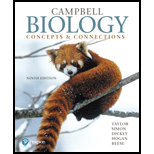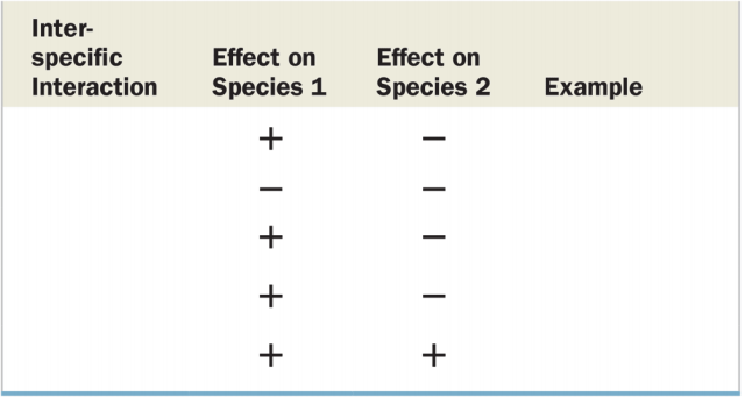
Concept explainers
Fill in the blanks in the table below summarizing the interspecific interactions in a community.

To complete: The blanks summarizing the interspecific interactions in a community.
Introduction: While surviving in an ecosystem, many species interact with each other. These interactions can be mutually beneficial or harmful for one or the other. There are five main types of interspecific interactions, namely, predation, competition, herbivory, parasitism, and mutualism.
Answer to Problem 1CC
Tabular representation: Table 1 represents the interspecific interactions in a community as follows:
| Interspecific interactions | Effect on species 1 | Effect on species 2 | Examples |
| Predation | + | - | Osprey/fish |
| Competition | - | - | Hyenas/vultures |
| Herbivory | + | - | Deer/shrub |
| Parasitism | + | - | Tapeworm/horse |
| Mutualism | + | + | Clown fish/anemone |
Table 1 Depicts the interspecific interactions in a community.
Explanation of Solution
The five types of interspecific interactions are as follows:
Predation: In predative interspecific interactions, one species preys on the other species for food or territory. It is a type of +/- interaction where one species benefits and the other species does not benefit. For example: interaction between a deer and a lion is predation.
Competition: It is the competitive interspecific interaction where two different types of species are competing for the same resource. Neither of them benefits from this, so it is a type of -/- interaction. For example: the interaction between vulture and hyenas.
Herbivory: It is the interaction between the herbivores and the plants. This interaction is a type of +/- interaction where the deer is benefited while the plant is not. For example: an interaction between deer and grass is herbivory.
Parasitism: It is parasitic form of interspecific interaction that involves one organism using the other for food and shelter. One organism such as the tapeworm inhabits the gut or any other part of the other organism such as the horse. This interaction is a +/- interactions, where only one is benefitted.
Mutualism: In this interaction, the organisms that are interacting are mutually beneficial for each other. One species provides one factor, while the other species provides another factor, for example, in the case of mycorrhiza, the fungus is in mutual interaction with the roots of the gymnosperm tree. The fungal element provides minerals and water from the soil, while the tree provides the nutrients. It is a +/+ form of interaction as both the organisms are benefitted.
Want to see more full solutions like this?
Chapter 37 Solutions
Campbell Biology: Concepts & Connections (9th Edition)
- Can you described the image? Can you explain the question as well their answer and how to get to an answer to an problem like this?arrow_forwardglg 112 mid unit assignment Identifying melting processesarrow_forwardGive only the mode of inheritance consistent with all three pedigrees and only two reasons that support this, nothing more, (it shouldn't take too long)arrow_forward
- Oarrow_forwardDescribe the principle of homeostasis.arrow_forwardExplain how the hormones of the glands listed below travel around the body to target organs and tissues : Pituitary gland Hypothalamus Thyroid Parathyroid Adrenal Pineal Pancreas(islets of langerhans) Gonads (testes and ovaries) Placentaarrow_forward
- What are the functions of the hormones produced in the glands listed below: Pituitary gland Hypothalamus Thyroid Parathyroid Adrenal Pineal Pancreas(islets of langerhans) Gonads (testes and ovaries) Placentaarrow_forwardDescribe the hormones produced in the glands listed below: Pituitary gland Hypothalamus Thyroid Parathyroid Adrenal Pineal Pancreas(islets of langerhans) Gonads (testes and ovaries) Placentaarrow_forwardPlease help me calculate drug dosage from the following information: Patient weight: 35 pounds, so 15.9 kilograms (got this by dividing 35 pounds by 2.2 kilograms) Drug dose: 0.05mg/kg Drug concentration: 2mg/mLarrow_forward
- A 25-year-old woman presents to the emergency department with a 2-day history of fever, chills, severe headache, and confusion. She recently returned from a trip to sub-Saharan Africa, where she did not take malaria prophylaxis. On examination, she is febrile (39.8°C/103.6°F) and hypotensive. Laboratory studies reveal hemoglobin of 8.0 g/dL, platelet count of 50,000/μL, and evidence of hemoglobinuria. A peripheral blood smear shows ring forms and banana-shaped gametocytes. Which of the following Plasmodium species is most likely responsible for her severe symptoms? A. Plasmodium vivax B. Plasmodium ovale C. Plasmodium malariae D. Plasmodium falciparumarrow_forwardStandard Concentration (caffeine) mg/L Absorbance Reading 10 0.322 20 0.697 40 1.535 60 2.520 80 3.100arrow_forwardPlease draw in the missing answer, thank youarrow_forward
 Biology Today and Tomorrow without Physiology (Mi...BiologyISBN:9781305117396Author:Cecie Starr, Christine Evers, Lisa StarrPublisher:Cengage Learning
Biology Today and Tomorrow without Physiology (Mi...BiologyISBN:9781305117396Author:Cecie Starr, Christine Evers, Lisa StarrPublisher:Cengage Learning Biology (MindTap Course List)BiologyISBN:9781337392938Author:Eldra Solomon, Charles Martin, Diana W. Martin, Linda R. BergPublisher:Cengage Learning
Biology (MindTap Course List)BiologyISBN:9781337392938Author:Eldra Solomon, Charles Martin, Diana W. Martin, Linda R. BergPublisher:Cengage Learning
 Concepts of BiologyBiologyISBN:9781938168116Author:Samantha Fowler, Rebecca Roush, James WisePublisher:OpenStax College
Concepts of BiologyBiologyISBN:9781938168116Author:Samantha Fowler, Rebecca Roush, James WisePublisher:OpenStax College Human Biology (MindTap Course List)BiologyISBN:9781305112100Author:Cecie Starr, Beverly McMillanPublisher:Cengage Learning
Human Biology (MindTap Course List)BiologyISBN:9781305112100Author:Cecie Starr, Beverly McMillanPublisher:Cengage Learning





